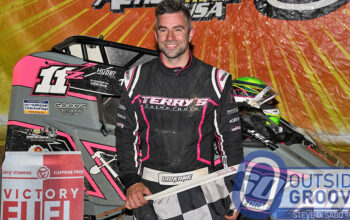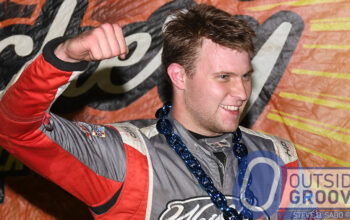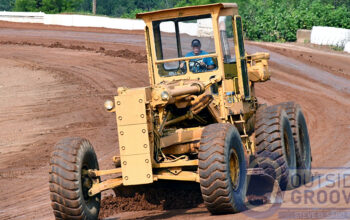Last Thursday, with Eddie Strada behind the wheel, Ability Motorsports won its first race. The triumph came in the SpeedSTR feature last Thursday at Bloomsburg Fair Raceway in Pennsylvania. Car owner Doug Williams formed the team for a purpose.
“I want to inspire people,” Williams, of Whitehall Township, Pennsylvania, said. “I want them to say, ‘Look at this guy, a paraplegic, who is fairly independent. He can drive, pull trailers, and work on cars.’”
And, he can win races, but that’s just the tip of the iceberg.
Williams fractured his C6 vertebra after diving off a five-foot embankment into a river on April Fool’s Day in 1986. It left him a paraplegic. Williams never regained the ability to walk. Instead, he uses a power chair for mobility.
Despite that, he’s an avid skier. Obtained a pilot’s license. Became a certified scuba diver. Competed in rugby. Played tennis.
He fielded his first big race car five years ago, with a sportsman modified.
“When we blew up my last spec engine last June, I knew it was time to sell the big car,” said Williams. “It was Keith Hoffman, of Hoffman Speed Supplies, where I am a volunteer worker, who encouraged me to push myself and not give up when the chips are down. He told me to keep racing, and the wins will come.”
That’s when Williams bought a SpeedSTR for driver Doug Snyder. Snyder then encouraged him to buy a second car. He later introduced Williams to Strada as a potential driver for that second ride.
Williams serves as team owner, manager, and co-crew chief on both cars. However, his best attribute may be cheerleader, both for his team and his cause.
He speaks regularly at the Spinal Cord Injury Support Group’s meetings held at Good Shepherd Rehabilitation Hospital in Allentown, Pennsylvania. There he met their president and CEO, Michael Spigel.
“[Spigel] and I spoke for an hour,” Williams said. “He was impressed with Ability Motorsports and gave us a $5,000 sponsorship.”
Doug Williams is working on turning Ability Motorsports into a 501(c)(3) non-profit organization. By doing so, he hopes to do more than win races.
“It is ability, not disability,” said Williams. “Our mission statement is to enable the inclusion of the disabled to spectate and/or participate in motorsports racing. The plan is to get severely disabled people out of the house and into the mainstream. We want them to enjoy what we love and live for.”
Mike Adaskaveg has written hundreds of stories since the website’s inception. This year marks his 54th year of covering auto racing. Adaskaveg got his start working for track photographer Lloyd Burnham at Connecticut’s Stafford Motor Speedway in 1970. Since then, he’s been a columnist, writer, and photographer, in racing and in mainstream media, for several outlets, including the Journal Inquirer, Boston Herald, Stock Car Racing, and Speedway Illustrated. Among Adaskaveg’s many awards are the 1992 Eastern Motorsport Press Association (EMPA) Ace Lane Photographer of the Year and the 2019 National Motorsports Press Association (NMPA) George Cunningham Writer of the Year.





